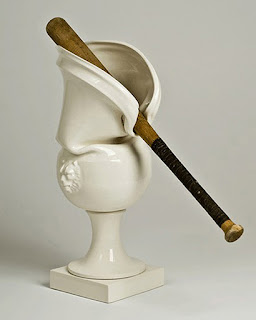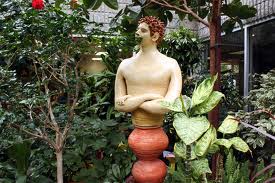Brent Coffin poses with the models in the "Living Gowns". All photos by Malin Enstrom.
During the Valentine's weekend I made sure to attend the
fashion show that animated the Living Gowns exhibition by Brent Coffin. I had heard Brent Coffin interviewed on
Mac Furlong's Weekend Arts CBC broadcast, Coffin explained that he had been a
visual arts student at the Grenfell campus and had been dragged kicking and
screaming into sewing by his professor Barb Hunt. I was curious to learn more. The show pairs gowns designed and created by Coffin with his
paintings that depicts the gowns worn by models. Coffin had said that in part the gowns were like portraits
of the women but I had a hard time imagining the relationship between the
2-dimensional images and the 3-dimensional gowns. The only way I was going to learn more was by seeing them
first hand and what better way than to see them come alive on the proverbial
catwalk.
Model in her Harem head-dress and gown by Brent Coffin.
I was not familiar with Brent Coffin's earlier painting so
in response to my query Bonnie Leyton pointed out an example for my
comparison. We both agreed the
stylistic term that best described Coffin's style, then and now, was
surrealistic. There is an element
of fantasy, an interior psychological world that Coffin shares with the
viewers. It is as if we have
interrupted something, an event or extraordinary narrative. It makes sense visually but it has its
own logic.
The new body of work revolves around the gowns, like the
peacock dress or candy corset gown, that seem almost like archetypes or larger
than life. The women have become
mythic or endowed with powers, such as the ability to summon waves to do her
bidding. The paintings suggest the
worlds wherein these things are possible.
The wave-dress painting.
Talking to the real people at the fashion show provided some
delightful doses of real life that augmented the fantastic. For example, Brent's husband mentioned
to me that Brent's day job was in retail at the dollar store and I thought that
was nothing less than perfect. It
seemed a Cinderella story come to life where Brent brought home the feathers
and sequins purchased from the store and transformed them into something that
would transport us from the cinders of everyday life into a magical world where
all things were possible.
Each of the models I spoke with voluntarily mentioned how
surprisingly comfortable their lavish gowns were. The harem model marveled at how light-weight her headdress
was for example. Elaborate collars
were detachable and several models commented that the dresses fit well. And these were women with ample curves
–not the usual rail-thin fashion models.
The fantasy gowns amplified aspects of the women's personalities and
bodies; redheads were complimented by green and turquoise toned fabrics and
details.
The fashion show event bristled with the cameras of well-wishing,
weekend (amateur) paparazzi.
Little girls played on the sidelines in their princess dresses and
tiaras. Brent Coffin's creations
made it possible for his real life, grown up women to assume equally regal
personas. Nobody was playing
pretend.











